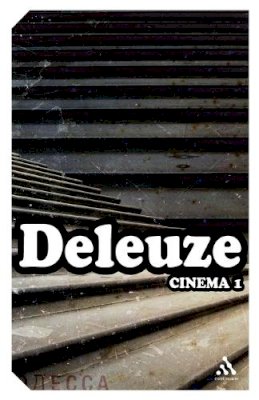23%OFF

Stock image for illustration purposes only - book cover, edition or condition may vary.
Cinema I
Gilles Deleuze
€ 69.32
€ 53.16
FREE Delivery in Ireland
Description for Cinema I
Paperback. Deleuze identifies three distinct principal types of 'image movement' and draws upon diverse examples from the work of such major filmmakers as Griffith, Eisenstein, Cassavetes and Altman. Series: Continuum Impacts. Num Pages: 280 pages, black & white illustrations. BIC Classification: APFA; HPCF. Category: (G) General (US: Trade); (P) Professional & Vocational; (U) Tertiary Education (US: College). Dimension: 198 x 129 x 22. Weight in Grams: 314. The Movement Image. Series: Continuum Impacts. 280 pages, black & white illustrations. Deleuze identifies three distinct principal types of 'image movement' and draws upon diverse examples from the work of such major filmmakers as Griffith, Eisenstein, Cassavetes and Altman. Cateogry: (G) General (US: Trade); (P) Professional & Vocational; (U) Tertiary Education (US: College). BIC Classification: APFA; HPCF. Dimension: 198 x 129 x 22. Weight: 310.
Gilles Deleuze (1925-1995) was Professor of Philosophy at the University of Paris VIII. He is one of the key figures in poststructuralism, and one of the most influential philosophers of the twentieth century. Cinema I is a revolutionary work in the theory of cinema and begins Deleuze's major reassessment of film, concluded in Cinema II. In it, Deleuze identifies three distinct principal types of 'image movement' and draws upon diverse examples from the work of such major filmmakers as Griffith, Eisenstein, Cassavetes and Altman. Translated by Hugh Tomlinson and Babara Habberjam.
Gilles Deleuze (1925-1995) was Professor of Philosophy at the University of Paris VIII. He is one of the key figures in poststructuralism, and one of the most influential philosophers of the twentieth century. Cinema I is a revolutionary work in the theory of cinema and begins Deleuze's major reassessment of film, concluded in Cinema II. In it, Deleuze identifies three distinct principal types of 'image movement' and draws upon diverse examples from the work of such major filmmakers as Griffith, Eisenstein, Cassavetes and Altman. Translated by Hugh Tomlinson and Babara Habberjam.
Product Details
Publisher
Bloomsbury Publishing PLC
Number of pages
280
Format
Paperback
Publication date
2005
Series
Continuum Impacts
Condition
New
Number of Pages
280
Place of Publication
London, United Kingdom
ISBN
9780826477057
SKU
V9780826477057
Shipping Time
Usually ships in 5 to 9 working days
Ref
99-10
About Gilles Deleuze
Gilles Deleuze (1925-1995) was Professor of Philosophy at the University of Paris VIII and one of the most influential philosophers of the twentieth century. He is the co-author of the renowned texts Anti-Oedipus and A Thousand Plateaus - both of which are available as Continuum Impacts.
Reviews for Cinema I
"Cinema I and Cinema II must be understood as works of philosophy, not of film criticism. They are Deleuze's reflection on the new ways the cinema enables us to think about time and movement, opening up insights into semiotics and our ideological construction of a world increasingly experienced through representational media.... The main purpose of these books is to identify and explore the implications of a vital shift from classical, pre-World War II cinema of the movement-image to post-World War II cinema of the time-imaging.... "Cinema 1 and Cinema 2 perhaps ultimately have more to teach us about philosophy, conceptions of subjectivity, and hermeneutics than to say something about any specific film. These books are challenging because they develop their own vocabulary in dialogue with the history of philosophy, and they assume a wide knowledge of films from the Soviet, European and Hollywood traditions. They reward the effort required to read them, however, for the original tools with which they provide us to understand cinema and semiotics more generally. Deleuze concludes that it is important to think of cinema not as a language, but as a way of bringing to light ‘intelligible content' which is a condition through which language constructs its objects (Cinema 2, p.251). Thus, purely optical and sound images which do not extend into action might be one way in which aesthetics might help us break outside of the determining structure of linguistic systems, enabling us to imagine the world otherwise. Deleuze helps us to see cinema as more than just a collection of texts but as additionally ‘a new practice of images and signs, whose theory philosophy must produce as conceptual practice' (Cinema 2, p. 269)."- Sherryl Vint, Film International, Issue 27v
Film International
Film International
